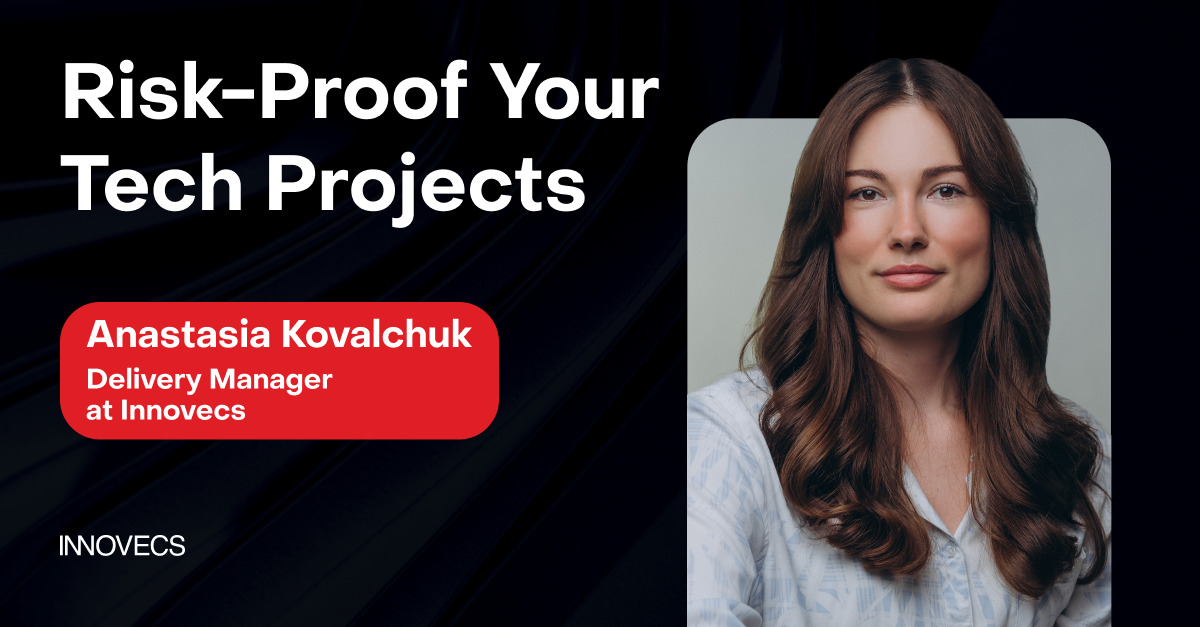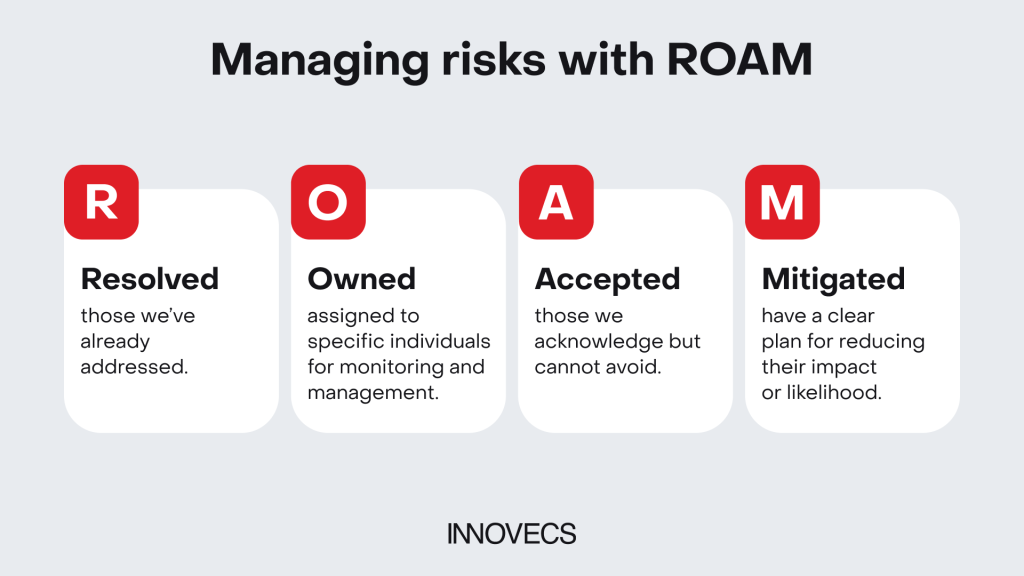
In this article, Anastasia Kovalchuk, Delivery Manager at Innovecs, outlines the company’s comprehensive approach to risk management in technology projects. By focusing on early risk identification, assessment, and mitigation, Innovecs ensures that projects stay on track, within budget, and meet high-quality standards. The article emphasizes the importance of clear communication, collaboration, and proactive management to build trust with clients and turn potential risks into opportunities for improvement. Using tools like the Probability and Impact Matrix, ROAM technique, and Fishbone diagram, Innovecs effectively navigates challenges, ensuring successful project outcomes and strong client relationships.
Partnering with Innovecs means trusting us with vital business data and processes. So, how do we handle such trust? With careful responsibility and a focus on minimizing uncertainty.
From day one, we prioritize risk management, allowing us to identify potential issues early and take preventive measures. This way, we set realistic expectations, avoid unnecessary delays or cost overruns, and consistently deliver high-quality solutions.
Risk management isn’t just a process for us; it’s the backbone of how we work with our clients. The open dialogue helps us address risks more effectively, improving decision-making and resource allocation. You can focus on what you do best while we handle the complexities, ensuring projects are delivered smoothly and to the highest standards.
Now, let’s shed some light on how we approach risk management for our clients.
Several common risk types can impact timelines, budgets, and overall success:
- Scope creep: This occurs when the project scope expands beyond the initial plan, often due to additional features or changes requested by stakeholders.
- Key personnel dependency: Relying heavily on a single team member who possesses unique, specialized knowledge can be risky. If this key person becomes unavailable, it can disrupt the project significantly.
- Unclear requirements: Projects often suffer from poorly defined or evolving requirements. Clients may not always provide detailed specifications, leading to misunderstandings and rework.
- Rapid technological changes: The fast-paced nature of technology can introduce new tools and frameworks during a project, which may not always integrate well with existing systems.
- Integration issues: Combining new software with existing systems can lead to compatibility problems.
By acknowledging these risks right off the bat, we take informed steps for effective project planning and execution.
At the start of any project, our primary focus is on clearly defining the project scope. This involves understanding the resources required and foreseeing potential issues that might arise. Detailed documentation of the scope ensures that all stakeholders have a mutual understanding of the project objectives and deliverables.
One of the first steps in our risk management process is the creation of a risk register. This register is a living document that lists potential risks, their impact, and the strategies for mitigating them. It’s shared with all stakeholders, both client-side and internally, to keep everyone aligned. Ideally, working with the risk register is an everyday process. Effective risk management involves constant communication with the team. It’s crucial to convey that everything discussed is aimed at improving the project and the quality of work.
To make this process effective, we focus on how team members voice their ideas. They must articulate their concerns clearly and listen to others to avoid misunderstandings. Our managers act as mediators, facilitating discussions without dictating solutions. Instead, they encourage open-ended questions like, “What do you think about this risk?” or “How can we address this issue together?” This approach ensures that everyone feels heard and contributes to risk mitigation strategies.
To effectively assess and prioritize risks, we utilize several tools and techniques. The Probability and Impact Matrix is particularly useful. It categorizes risks as low, medium, or high in terms of both probability and impact. This visual representation helps us quickly identify which risks need immediate attention and which can be monitored over time. By addressing high-priority risks first, we ensure that our projects stay on track and within budget.
Another critical tool we use is the ROAM technique (Resolved, Owned, Accepted, Mitigated). This method helps us categorize risks based on their current status:

We also utilize tools like the Fishbone diagram, which helps us break down complex risks into manageable components. This tool allows us to identify the root causes of risks and develop targeted mitigation strategies.
Our approach is pretty much guided by the golden triangle of project management: time, budget, and scope. Any changes in one of these elements affect the other two, helping us determine the priority of risks based on their impact on these critical aspects.
A great example of our risk management approach in action is a project localization for the French market. Our team was responsible for a significant portion of earnings in this market, and missing deadlines or failing to meet harsh localization requirements could have resulted in substantial losses. To manage this risk, we prioritized the most critical website pages for localization, leaving less critical ones as optional tasks. This approach ensured timely delivery and mitigated the risk of project delays.
Meaningful relationships with clients are a cornerstone of our approach at Innovecs. From the very start of a project, we are clear that initial estimates are preliminary and that timing, budget, and scope may evolve as we gather more detailed requirements. By maintaining open lines of communication and providing regular updates on project dependencies, we manage expectations and address risks ahead of time. This transparency ensures that all stakeholders remain aligned and that trust is built from day one.
We always share hypothetical scenarios, such as potential vendor delays, and explain our mitigation plans. This not only prepares clients for possible challenges but also demonstrates our forward-thinking approach to risk management. We emphasize that risks are not inherently negative; they can be opportunities for improvement and innovation.
Our communication strategy goes beyond simply sharing information; it’s about fostering a collaborative environment. We actively engage clients in the risk management process, encouraging them to share their insights and concerns. Thus, we ensure that we are not only managing risks effectively but also continuously improving our processes and delivering value to our clients.
At Innovecs, we believe that open, honest, and proactive communication is key to successful project outcomes and long-lasting client relationships.


